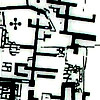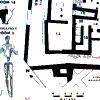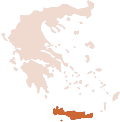Palekastro
 What we call "Palekastro" today is a Minoan town unearthed at the Rousolakos location near the modern town of Palekastro. It is located strategically at the East shore of Crete adjacent to the sheltered harbor of Chiona, a few kilometers North of the palace of Kato Zakros. The town is still undergoing excavations, and what has been unearthed to date reveal a vigorous commercial hub that was home to an affluent community. The homes, especially those facing the main road were very impressive, can find evidence of affluence in a large building found in area B with a kitchen, four rows of columns, a bathing tank, a well, an altar, a bathroom, and an oil storage facility. A complete sewage systems serviced the entire town. Many every day utilitarian artifacts were found in the ruins like amphoras and oil lamps, along with some precious objects like the Ivory statuette now exhibited at the Sitia Museum.
What we call "Palekastro" today is a Minoan town unearthed at the Rousolakos location near the modern town of Palekastro. It is located strategically at the East shore of Crete adjacent to the sheltered harbor of Chiona, a few kilometers North of the palace of Kato Zakros. The town is still undergoing excavations, and what has been unearthed to date reveal a vigorous commercial hub that was home to an affluent community. The homes, especially those facing the main road were very impressive, can find evidence of affluence in a large building found in area B with a kitchen, four rows of columns, a bathing tank, a well, an altar, a bathroom, and an oil storage facility. A complete sewage systems serviced the entire town. Many every day utilitarian artifacts were found in the ruins like amphoras and oil lamps, along with some precious objects like the Ivory statuette now exhibited at the Sitia Museum.
 The location could not be any more appropriate for settlement. Fertile land all around would have provided ample crops to sustain a large local population. The bay of Chiona is situated in such way that the sea is sheltered from the relentless meltemi winds which blow from the North in the summer, and would have made the life miserable for ancient mariners trying to sail North and around cape Sideros to deliver goods to Malia or Knossos. Palekastro, unlike Zakros has relatively easy access towards the interior of the island. The two neighboring harbors of Chiona, and Kouremenos immediately to the north are still rich fishing grounds just like they must have been in ancient times. The life of Minoan Palekastro came to an abrupt end in 1400 (or 1500) BC at the same time the other Minoan Palaces and towns, and while there is no conclusive evidence, the volcanic eruption of Thera, or foreign invasion, or a combination of the two appears as the most likely cause for the catastrophe.
The location could not be any more appropriate for settlement. Fertile land all around would have provided ample crops to sustain a large local population. The bay of Chiona is situated in such way that the sea is sheltered from the relentless meltemi winds which blow from the North in the summer, and would have made the life miserable for ancient mariners trying to sail North and around cape Sideros to deliver goods to Malia or Knossos. Palekastro, unlike Zakros has relatively easy access towards the interior of the island. The two neighboring harbors of Chiona, and Kouremenos immediately to the north are still rich fishing grounds just like they must have been in ancient times. The life of Minoan Palekastro came to an abrupt end in 1400 (or 1500) BC at the same time the other Minoan Palaces and towns, and while there is no conclusive evidence, the volcanic eruption of Thera, or foreign invasion, or a combination of the two appears as the most likely cause for the catastrophe.
 The ruins at the archaeological site that has been excavated must comprise a very small part of a vast settlement. One gets the feeling that the olive groves beyond the site itself hide a wealth of minoan secrets under their soil, and in fact, fragments of pottery along the beach, and large stones on the headland that frames the sandy beach to the South testify to the abundant existence of archaeological ruins and artifacts. This is the result of intense settlement on the area over a few millennia. The excavations at Palekastro began in the early 1900 AD and still continue to reveal the rich strata of archaeological evidence that begins in the Minoan period and continues to historical times. "Radiophotography" surveillance of the site has provided evidence of a fifth Minoan palace buried under the earth.
The ruins at the archaeological site that has been excavated must comprise a very small part of a vast settlement. One gets the feeling that the olive groves beyond the site itself hide a wealth of minoan secrets under their soil, and in fact, fragments of pottery along the beach, and large stones on the headland that frames the sandy beach to the South testify to the abundant existence of archaeological ruins and artifacts. This is the result of intense settlement on the area over a few millennia. The excavations at Palekastro began in the early 1900 AD and still continue to reveal the rich strata of archaeological evidence that begins in the Minoan period and continues to historical times. "Radiophotography" surveillance of the site has provided evidence of a fifth Minoan palace buried under the earth.
Palekastro Picture Highlights
 |
 |
 |
| Picture of the archaeological site of Palekastro. | Picture of the main street of Palekastro. | Picture of Building 5. It is covered to protect its plaster walls from the elements while excavations continue. |
 |
 |
 |
| Plan and picture of Building 5 at Palekastro indicating where the ivory statuette was found. (Large file 349k) |
Picture of the steps of the building 5 entrance where one of the statuette (right) pieces was found. Another piece was found in the second room beyond the steps (room 2). Two more pieces were found around the area where I am standing to take this picture. |
The statuette in its current state as exhibited at the Archaeological Museum of Sitia. |
Next: Palekastro Pictures

